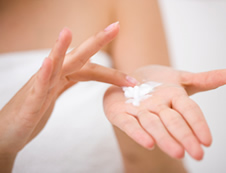
Mohs Surgery
Mohs Micrographic Surgery (or simply Mohs Surgery) is an innovative option for the treatment of skin cancers that offers a projected 99% cure rate for such cancers, the highest potential cure rate for available treatment options. It is a technique that may be performed by a trained Mohs surgeon, such as Dr. Mandy Warthan, in order to remove the least amount of tissue possible, which offers superior cosmetic results, while still allowing the Mohs surgeon to remove the entire tumor.
Mole Removal
Moles are pigmented brown or black spots on the skin that may be present at birth or develop from aging or sun damage. While usually harmless, it is important to monitor moles for any changes.
Depending on the depth and location of the mole, as well as the patient’s skin type and overall health, mole removal may involve laser or pulsed light therapy, microdermabrasion. We would remove a mole by surgical excising it only. Dr. Warthan will decide which treatment is best for you.
Skin Cancer Screening
 Regular skin cancer screening is important in detecting any changes as early as possible and increasing the chance of successful treatment.
Regular skin cancer screening is important in detecting any changes as early as possible and increasing the chance of successful treatment.
Dr. Warthan performs full body skin exams to screen for benign or cancerous lesions that patients may not be able to see or recognize on their own. Additional testing may be performed if any abnormalities are found.
Cyst Removal
Cyst removal is typically done through surgical excision. A small incision is made in the area of the cyst and then the cyst and surrounding tissue will be removed to ensure complete excision. A local anesthetic is used for this procedure. Most cysts do not return when thoroughly removed. Some patients are left with a small scar after a cyst is removed, which can be further treated with a reconstructive treatment, although most scars will fade over time.
Hair Loss
While daily shedding is normal, people who notice their hair shedding in large amounts after combing or brushing, or whose hair becomes thinner or falls out, should consult a Dermatologist for proper diagnosis and treatment.
Acne Treatment
 Acne is the term for blocked pores (blackheads and whiteheads), pimples, and deeper lumps (cysts or nodules) that can appear typically on the face, neck, chest, back, shoulders and upper arms. Although usually harmless, acne can lead to scarring and emotional distress for those affected. Fortunately, there are many treatment options available for acne, including topical medications, antibiotics, Accutane®, chemical peels, and laser treatment and more.
Acne is the term for blocked pores (blackheads and whiteheads), pimples, and deeper lumps (cysts or nodules) that can appear typically on the face, neck, chest, back, shoulders and upper arms. Although usually harmless, acne can lead to scarring and emotional distress for those affected. Fortunately, there are many treatment options available for acne, including topical medications, antibiotics, Accutane®, chemical peels, and laser treatment and more.
Rosacea
Rosacea is a chronic skin disease that causes redness and swelling on the face, scalp, neck, ears, chest, back and/or eyes. Symptoms range from red pimples, lines and visible blood vessels to dry or burning skin and a tendency to flush easily. It is not yet known what causes rosacea and the disease is not curable, although it can be treated with topical and oral medications, laser therapy or laser surgery.
Rashes
Rashes have many causes, including allergic reactions. See your Dermatologist for successful diagnosis and treatment of rashes.
Skin Allergies
There are several factors that may cause an allergic reaction on your skin. A Dermatologist will properly diagnosis the problem, prescribe medication, or recommend products to decrease irritation.
Eczema
 Eczema is a group of inflamed skin conditions that result in chronic itchy rashes. Symptoms vary from person to person but often include dry, red, itchy patches on the skin which break out in rashes when scratched. Treatment involves the restriction of scratching, use of moisturizing lotions or creams, cold compresses, nonprescription anti-inflammatory corticosteroid creams and ointments or phototherapy.
Eczema is a group of inflamed skin conditions that result in chronic itchy rashes. Symptoms vary from person to person but often include dry, red, itchy patches on the skin which break out in rashes when scratched. Treatment involves the restriction of scratching, use of moisturizing lotions or creams, cold compresses, nonprescription anti-inflammatory corticosteroid creams and ointments or phototherapy.
Warts
Warts are skin growths caused by viruses. Different warts respond to different treatments. Some go away on their own. Salicylic acid products (in the form of drops, gels, pads and bandages) can help self-treatment of many warts by dissolving the keratin protein that makes up the wart and the dead skin above it. Others can be removed via liquid nitrogen freezing or electrical stimulation. Surgery may be recommended for painful or large warts that do not respond to these treatments.
Skin Tag Removal
Skin tags are common, acquired, benign skin growths that look like a small piece of soft, hanging skin. Skin tags are harmless growths. They can be safely removed by a Dermatologist.
Molluscum
Molluscum contagiosum is a chronic skin infection caused by a virus which is quite common among children, and is usually spread by touching an affected area on a person infected with the virus. Molluscum causes painless, raised papules or nodules on the skin that look like pink pearls on the face, neck, arms, hands and chest.
Most cases of molluscum heal on their own within six to 18 months. Patients should try not to scratch the papules, or else they risk scarring and bacterial infection. If necessary, a Dermatologist can remove individual lesions.
Hyperhidrosis
 Hyperhidrosis is a rare condition that causes excessive sweating on the hands, feet, armpits, face and genital area, or all over the entire body. Treatment for hyperhidrosis depends on the severity of the condition, but may include prescription-strength antiperspirant or medication to help control sweating or stop the stimulation of the sweat glands. BOTOX® injections in the armpits block the nerves that cause sweating and can effectively treat hyperhidrosis for up to eight months for each injection. In severe cases, surgery may be required to remove the nerves that control the sweat glands, or the actual glands themselves.
Hyperhidrosis is a rare condition that causes excessive sweating on the hands, feet, armpits, face and genital area, or all over the entire body. Treatment for hyperhidrosis depends on the severity of the condition, but may include prescription-strength antiperspirant or medication to help control sweating or stop the stimulation of the sweat glands. BOTOX® injections in the armpits block the nerves that cause sweating and can effectively treat hyperhidrosis for up to eight months for each injection. In severe cases, surgery may be required to remove the nerves that control the sweat glands, or the actual glands themselves.
Ear Piercing
Our medical staff provides a safe and hygienic alternative to stores at the mall and tattoo shops. Avoid infection and poor placement, have your family get their ears pierced in a sterile office.
Nail Problems
There are several different diseases that affect the nails, often as a result of a fungal or bacterial infection. Ingrown toenails are the most common nail ailment, involving the corners of the nails digging into the surrounding soft tissue, causing irritation and swelling. Fungal infection commonly affects the toenails (and sometimes the fingernails as well), as a result of exposure to a warm, moist environment, and cause thick, brittle and distorted nails.
Treatment for nail diseases may include oral or topical medications. The nail may need to be removed for severe infections. Patients can prevent nail conditions from developing by keeping the feet clean and dry, wearing shoes that fit well and clipping toenails straight across.
SCHEDULE AN APPOINTMENT
240 Adriatic Parkway, McKinney, TX 75072
12255 University Dr. Frisco, TX 75035